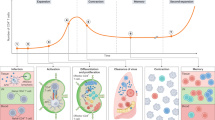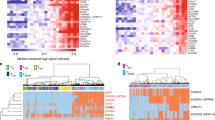Abstract
We propose that CD4+CD3− cells have two functions: a well-established role in organizing lymphoid tissue during development, and a newly discovered role in supporting T-cell help for B cells both during affinity maturation in germinal centres and for memory antibody responses. As CD4+CD3− cells express the HIV co-receptors CD4 and CXC-chemokine receptor 4, we think that infection of these cells by HIV, and their subsequent destruction by the host immune system, could help to explain the loss of memory antibody responses and the destruction of lymphoid architecture that occur during disease progression to AIDS.
This is a preview of subscription content, access via your institution
Access options
Subscribe to this journal
Receive 12 print issues and online access
$209.00 per year
only $17.42 per issue
Buy this article
- Purchase on Springer Link
- Instant access to full article PDF
Prices may be subject to local taxes which are calculated during checkout



Similar content being viewed by others
References
Mebius, R. E. Organogenesis of lymphoid tissues. Nature Rev. Immunol. 3, 292–303 (2003).
Kim, M. Y. et al. CD4+CD3− accessory cells costimulate primed CD4 T cells through OX40 and CD30 at sites where T cells collaborate with B cells. Immunity 18, 643–654 (2003).
Liu, Y. J., Zhang, J., Lane, P. J., Chan, E. Y. & MacLennan, I. C. Sites of specific B cell activation in primary and secondary responses to T cell-dependent and T cell-independent antigens. Eur. J. Immunol. 21, 2951–2962 (1991).
Garside, P. et al. Visualization of specific B and T lymphocyte interactions in the lymph node. Science 281, 96–99 (1998).
Nakano, H., Yanagita, M. & Gunn, M. D. CD11c+B220+Gr-1+ cells in mouse lymph nodes and spleen display characteristics of plasmacytoid dendritic cells. J. Exp. Med. 194, 1171–1178 (2001).
Grouard, G., Durand, I., Filgueira, L., Banchereau, J. & Liu, Y. J. Dendritic cells capable of stimulating T-cells in germinal-centers. Nature 384, 364–367 (1996).
Metlay, J. et al. The distinct leukocyte integrins of mouse dendritic cells as identified with new hamster monoclonal antibodies. J. Exp. Med. 171, 1753–1771 (1990).
Mason, D. Y. et al. (eds) Leukocyte Typing VII (Oxford Univ. Press, New York, 2002).
Linton, P. J. et al. Costimulation via OX40L expressed by B cells is sufficient to determine the extent of primary CD4 cell expansion and TH2 cytokine secretion in vivo. J. Exp. Med. 197, 875–883 (2003).
Kim, M. Y. et al. OX40 signals during priming on dendritic cells inhibit CD4 T cell proliferation: IL-4 switches off OX40 signals enabling rapid proliferation of TH2 effectors. J. Immunol. 174, 1433–1437 (2005).
Aggarwal, B. B. Signalling pathways of the TNF superfamily: a double-edged sword. Nature Rev. Immunol. 3, 745–756 (2003).
Croft, M. Co-stimulatory members of the TNFR family: keys to effective T-cell immunity? Nature Rev. Immunol. 3, 609–620 (2003).
Rogers, P. R., Song, J., Gramaglia, I., Killeen, N. & Croft, M. OX40 promotes Bcl-xL and Bcl-2 expression and is essential for long-term survival of CD4 T cells. Immunity 15, 445–455 (2001).
Gaspal, F. M. C. et al. Mice deficient in OX40 and CD30 signals lack memory antibody responses because of deficient CD4 T cell memory. J. Immunol. 174, 3891–3896 (2005).
Chen, A. I. et al. Ox40-ligand has a critical costimulatory role in dendritic cell:T cell interactions. Immunity 11, 689–698 (1999).
Kopf, M. et al. OX40-deficient mice are defective in TH cell proliferation but are competent in generating B cell and CTL responses after virus infection. Immunity 11, 699–708 (1999).
Pippig, S. D. et al. Robust B cell immunity but impaired T cell proliferation in the absence of CD134 (OX40). J. Immunol. 163, 6520–6529 (1999).
Murata, K. et al. Impairment of antigen-presenting cell function in mice lacking expression of OX40 ligand. J. Exp. Med. 191, 365–374 (2000).
Amakawa, R. et al. Impaired negative selection of T cells in Hodgkin's disease antigen CD30-deficient mice. Cell 84, 551–562 (1996).
Texido, G. et al. Somatic hypermutation occurs in B cells of terminal deoxynucleotidyl transferase-, CD23-, interleukin-4-, IgD- and CD30-deficient mouse mutants. Eur. J. Immunol. 26, 1966–1969 (1996).
Gowans, J. L. & Uhr, J. W. The carriage of immunological memory by small lymphocytes in the rat. J. Exp. Med. 124, 1017–1030 (1966).
Ansel, K. M., McHeyzer-Williams, L. J., Ngo, V. N., McHeyzer-Williams, M. G. & Cyster, J. G. In vivo-activated CD4 T cells upregulate CXC chemokine receptor 5 and reprogram their response to lymphoid chemokines. J. Exp. Med. 190, 1123–1134 (1999).
Breitfeld, D. et al. Follicular B helper T cells express CXC chemokine receptor 5, localize to B cell follicles, and support immunoglobulin production. J. Exp. Med. 192, 1545–1552 (2000).
Luther, S. A., Tang, H. L., Hyman, P. L., Farr, A. G. & Cyster, J. G. Coexpression of the chemokines ELC and SLC by T zone stromal cells and deletion of the ELC gene in the plt/plt mouse. Proc. Natl Acad. Sci. USA 97, 12694–12699 (2000).
Gunn, M. D. et al. A B-homing chemokine made in lymphoid follicles activates Burkitt's lymphoma type receptor-1. Nature 391, 799–802 (1998).
Reif, K. et al. Balanced responsiveness to chemoattractants from adjacent zones determines B-cell position. Nature 416, 94–99 (2002).
Li, J., Huston, G. & Swain, S. L. IL-7 promotes the transition of CD4 effectors to persistent memory cells. J. Exp. Med. 198, 1807–1815 (2003).
Kondrack, R. M. et al. Interleukin 7 regulates the survival and generation of memory CD4 cells. J. Exp. Med. 198, 1797–1806 (2003).
Seddon, B., Tomlinson, P. & Zamoyska, R. Interleukin 7 and T cell receptor signals regulate homeostasis of CD4 memory cells. Nature Immunol. 4, 680–686 (2003).
Kroncke, R., Loppnow, H., Flad, H. D. & Gerdes, J. Human follicular dendritic cells and vascular cells produce interleukin-7: a potential role for interleukin-7 in the germinal center reaction. Eur. J. Immunol. 26, 2541–2544 (1996).
Kim, M. -Y. et al. OX40 ligand and CD30 ligand are expressed on adult but not neonatal CD4+CD3− inducer cells: evidence that IL-7 signals regulate CD30 ligand but not OX40 ligand expression. J. Immunol. 174, 6686–6691 (2005).
Billingham, R. E., Brent, L. & Medawar, P. B. Activity acquired tolerance of foreign cells. Nature 172, 603–606 (1953).
Mebius, R. E., Rennert, P. & Weissman, I. L. Developing lymph nodes collect CD4+CD3− LTβ+ cells that can differentiate to APC, NK cells, and follicular cells but not T or B cells. Immunity 7, 493–504 (1997).
Eberl, G. et al. An essential function for the nuclear receptor RORγt in the generation of fetal lymphoid tissue inducer cells. Nature Immunol. 5, 64–73 (2004).
Eberl, G. & Littman, D. R. Thymic origin of intestinal αβ T cells revealed by fate mapping of RORγt+ cells. Science 305, 248–251 (2004).
Sun, Z. et al. Requirement for RORγ in thymocyte survival and lymphoid organ development. Science 288, 2369–2373 (2000).
Kurebayashi, S. et al. Retinoid-related orphan receptor γ (RORγ) is essential for lymphoid organogenesis and controls apoptosis during thymopoiesis. Proc. Natl Acad. Sci. USA 97, 10132–10137 (2000).
Ohl, L. et al. Cooperating mechanisms of CXCR5 and CCR7 in development and organization of secondary lymphoid organs. J. Exp. Med. 197, 1199–1204 (2003).
Cupedo, T. et al. Initiation of cellular organization in lymph nodes is regulated by non-B cell-derived signals and is not dependent on CXC chemokine ligand 13. J. Immunol. 173, 4889–4896 (2004).
Fu, Y. X. et al. Lymphotoxin-α (LTα) supports development of splenic follicular structure that is required for IgG responses. J. Exp. Med. 185, 2111–2120 (1997).
Ngo, V. N. et al. Lymphotoxin α/β and tumor necrosis factor are required for stromal cell expression of homing chemokines in B and T cell areas of the spleen. J. Exp. Med. 189, 403–412 (1999).
Yokota, Y. et al. Development of peripheral lymphoid organs and natural killer cells depends on the helix–loop–helix inhibitor Id2. Nature 397, 702–706 (1999).
Kumar, S. & Hedges, S. B. A molecular timescale for vertebrate evolution. Nature 392, 917–920 (1998).
Connolly, J. H., Canfield, P. J., McClure, S. J. & Whittington, R. J. Histological and immunohistological investigation of lymphoid tissue in the platypus (Ornithorhynchus anatinus). J. Anat. 195, 161–171 (1999).
Koni, P. A. et al. Distinct roles in lymphoid organogenesis for lymphotoxins α and β revealed in lymphotoxin β-deficient mice. Immunity 6, 491–500 (1997).
Ochs, H. D. et al. Abnormal antibody responses in patients with persistent generalized lymphadenopathy. J. Clin. Immunol. 8, 57–63 (1988).
Janoff, E. N., Hardy, W. D., Smith, P. D. & Wahl, S. M. Humoral recall responses in HIV infection. Levels, specificity, and affinity of antigen-specific IgG. J. Immunol. 147, 2130–2135 (1991).
Mori, S., Takami, T., Nakamine, H., Miyayama, H. & Nakamura, S. Involution of lymph node histiocytes in AIDS. Acta Pathol. Jpn 39, 496–502 (1989).
Fauci, A. S. HIV and AIDS: 20 years of science. Nature Med. 9, 839–843 (2003).
Brenchley, J. M. et al. CD4+ T cell depletion during all stages of HIV disease occurs predominantly in the gastrointestinal tract. J. Exp. Med. 200, 749–759 (2004).
Heath, S. L., Tew, J. G., Szakal, A. K. & Burton, G. F. Follicular dendritic cells and human immunodeficiency virus infectivity. Nature 377, 740–744 (1995).
Burke, A. P. et al. Systemic lymphadenopathic histology in human immunodeficiency virus-1-seropositive drug addicts without apparent acquired immunodeficiency syndrome. Hum. Pathol. 25, 248–256 (1994).
Koopman, G., Haaksma, A. G., ten Velden, J., Hack, C. E. & Heeney, J. L. The relative resistance of HIV type 1-infected chimpanzees to AIDS correlates with the maintenance of follicular architecture and the absence of infiltration by CD8+ cytotoxic T lymphocytes. AIDS Res. Hum. Retroviruses 15, 365–373 (1999).
Hahn, B. H., Shaw, G. M., De Cock, K. M. & Sharp, P. M. AIDS as a zoonosis: scientific and public health implications. Science 287, 607–614 (2000).
Stebbing, J., Gazzard, B. & Douek, D. C. Where does HIV live? N. Engl. J. Med. 350, 1872–1880 (2004).
Pretet, J. L., Zerbib, A. C., Girard, M., Guillet, J. G. & Butor, C. Chimpanzee CXCR4 and CCR5 act as coreceptors for HIV type 1. AIDS Res. Hum. Retroviruses 13, 1583–1587 (1997).
Silvestri, G. et al. Nonpathogenic SIV infection of sooty mangabeys is characterized by limited bystander immunopathology despite chronic high-level viremia. Immunity 18, 441–452 (2003).
Siliciano, J. D. et al. Long-term follow-up studies confirm the stability of the latent reservoir for HIV-1 in resting CD4+ T cells. Nature Med. 9, 727–728 (2003).
Price, D. A. et al. T cell receptor recognition motifs govern immune escape patterns in acute SIV infection. Immunity 21, 793–803 (2004).
McMichael, A. & Hanke, T. The quest for an AIDS vaccine: is the CD8+ T-cell approach feasible? Nature Rev. Immunol. 2, 283–291 (2002).
Burton, D. R. et al. HIV vaccine design and the neutralizing antibody problem. Nature Immunol. 5, 233–236 (2004).
Acknowledgements
This work was supported by the Wellcome Trust (United Kingdom). We thank I. MacLennan, F. McConnell and G. Anderson for reading the manuscript and providing many helpful comments. We also thank C. Raykundalia, who organized us and made sure that everything in the laboratory worked.
Author information
Authors and Affiliations
Corresponding author
Ethics declarations
Competing interests
The authors declare no competing financial interests.
Rights and permissions
About this article
Cite this article
Lane, P., Gaspal, F. & Kim, MY. Two sides of a cellular coin: CD4+CD3− cells regulate memory responses and lymph-node organization. Nat Rev Immunol 5, 655–660 (2005). https://doi.org/10.1038/nri1665
Published:
Issue Date:
DOI: https://doi.org/10.1038/nri1665
This article is cited by
-
Lymphoid tissue inducer cells in cancer: a potential therapeutic target
Molecular and Cellular Biochemistry (2023)
-
CD30L/CD30 is critical for maintenance of IL-17A-producing γδ T cells bearing Vγ6 in mucosa-associated tissues in mice
Mucosal Immunology (2013)
-
Natural killer cell receptor-expressing innate lymphocytes: more than just NK cells
Cellular and Molecular Life Sciences (2011)
-
Signals that influence T follicular helper cell differentiation and function
Seminars in Immunopathology (2010)
-
Lymphoid tissue inducer cells: bridges between the ancient innate and the modern adaptive immune systems
Mucosal Immunology (2009)



